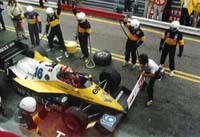MEMORIES / Turbo nirvana
Author
- Mattijs Diepraam
Date
- April 26, 2005
Related articles
- 1976 Dutch GP - An unburdened visit to Zandvoort, by Mattijs Diepraam
- 1981 Dutch GP - Ugly teenager surrounded by campsite beauties, by Mattijs Diepraam
- 1984 & 1985 Dutch GPs - Second dawn of the turbo, by Mattijs Diepraam
Who?Eddie Cheever What?Renault RE40 Where?Zandvoort When?XXXII Dutch GP (August 28, 1983) |
 |
Why?
Twelve Cosworth-engined cars entered the 1983 Dutch GP. And while there were only two of them left in 1984 (later officially reduced to none), with zero remaining in 1985, I still consider my visit to the 1983 race as a personal turbo nirvana.
Agreed, the final Dutch GP saw a cracking finale between the old Rat and his diminutive pretender, and gave a deserved decent farewell to the World Championship event in the dunes. But both that event and the preceding edition were really no more than two McLaren-TAG Porsche benefits. The 1983 Grand Prix would still be the zenith of turbo madness at both its best and worst - raw outbursts of imperfect technology, loony qualifying power, poisonous rocket fuels, beautiful cars spoilt by silly add-on winglets, fierce rivalry among the teams without a dominant force in sight.
Well, it was in sight, actually. But we didn't realise.
The Dutch GP saw the competition debut of McLaren's first turbo baby, the MP4/1E hybrid, making a circumspect first appearance in practice and qualifying. With Renault, Brabham and Ferrari already hundreds of miles and Grand Prix victories ahead of Ron Dennis's game, there were chuckles when Niki Lauda put it 19th on the grid. A year later they would be humbled by the first proper MP4 turbo machine.
Also, between the Austrian and Dutch GPs Keke Rosberg and Jacques Laffite re-signed for another season of Williams or, in fact, Williams-Honda. Between the two former garagistes that along with Tyrrell tried longest to beat the turbos before joining them, the McLaren and Williams teams would be the ones that would come out of the turbo era with most of the silverware, reaching a level of preparation that would put the old-school manufacturers squarely in the shade.
But for now, the 1983 Dutch GP still ahead of us, it was still a three-horse race between Brabham, Renault and Ferrari, with Maranello delivering the outside bets for the drivers' championship while raking up the constructors points in the process. It was still a matter of getting to the end - one was never sure which engine was going to make it. There was neither clockwork reliability. nor bespoke victories for the dominant force in the game.
As in previous years I had the chance to see the race up close from the Esso VIP box which would be straight above the Renault pit area this time. Having added another two years to my age since my 1981 visit I was starting to become a youngster who was daring to permit himself some artistic license when it came to photography, and so apart from the regular paddock shots of mechanics working on cars, I proceeded to duck, crawl and bend the knees to get some off-beat end results. The camera was still crummy, though, and the talent probably as well. A look at the picture gallery reveals how I at least tried...
The race itself was eventful, to say the least, although the end was somehow anti-climactic. Everything had been building up to a showdown between the two title pretenders, Piquet and Prost, and sure enough, that was what we got. But it didn't go the wire as we all hoped. Nelson Piquet in the striking BT52 had taken pole showing the first sign of Brabham's late-season resurgence, taking the battle to championship leader Prost. The Frenchman had set fourth time and lined up behind Tambay and next to the first of the two flying Lotus cars, each outpacing a similarly engined works Renault car. The start made all that irrelevant as the two Lotuses banged wheels while Eddie Cheever flew past almost the entire front half of the grid to grab second behind Piquet as the pack headed into Tarzan. Prost was third ahead of Patrese. The Brabham-Renault-Renault-Brabham Big Mac was followed by De Cesaris, Arnoux and De Angelis.
As Cheever dropped back into the clutches of Patrese and Arnoux, with René getting ahead of the second Brabham too, the lead battle was hotting up. It all ended up in tears on lap 42. I had just seen Cheever give up right beneath me when Piquet and Prost approached Tarzan. No one was yet sensing that they would do a remake of Andretti vs Hunt but still René Arnoux found himself being gifted the lead when he saw the stranded BT52 and went past a limping Renault with terminal front-wing damage. Prost being faster at that moment had become impatient and lunged into a gap that wasn't there, punting off Nelson and taking himself out as well. The remaining 30 laps would be a stroll to the chequered for Arnoux, especially when Patrese's BMW engine let go in spectacular fashion on lap 70, making that the second blown turbo of the day after De Cesaris's early exit on lap 5.
There was plenty of other excitement too. Patrick Tambay, one of my favourites, botched his start from the first row of the grid and went into Tarzan 21st. His climb to an eventual second place behind his team-mate was the most impressive feat of the race, while Derek Warwick finished fourth for Toleman after having run as high as second at Brands six weeks before. This time though, he wasn't running half tanks...
